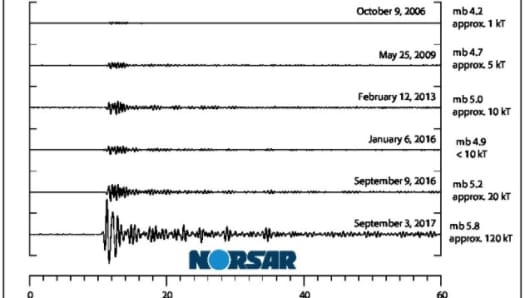North Korea claims successful hydrogen bomb test
- North Korea said on state television on Sunday afternoon that it successfully carried out a test of a hydrogen bomb intended to be carried by an ICBM

Ed Jones | AFP | Getty Images
People watch a television display at a train station in Seoul on September 3, 2017 showing a news broadcast about North Korea's latest possible nuclear test.
North Korea said on state television on Sunday afternoon that it successfully carried out a test of a hydrogen bomb intended to be carried by an intercontinental ballistic missile.
"North Korea's supreme dear leader signed the order to test hydrogen bomb to be fitted to the ICBM and accordingly North Korea has tested a hydrogen bomb at noon on Sept. 3rd (North Korea time) and succeeded totally," a female newscaster said on the KCNA televised announcement, according to an NBC News translation.
A hydrogen bomb is much more powerful than the simpler types of atomic weapons tested by North Korea five times previously, or the bombs dropped on Japan during World War II. H-bombs are also harder to develop.
The test, which the North said was a "perfect success," produced a greater yield than previous tests, with no adverse impact on the environment, North Korea's news agency KCNA said in a statement.
The bomb was "of unprecedentedly big power," and marked a "very significant occasion" toward a final goal of becoming a nuclear state, the full text of the announcement said.
North Korea's announcement followed reports of as many as two tremors in the rogue state at around noon local time, which officials in South Korea and Japan had said appeared to be the country's sixth nuclear test.
Norway-based geoscience research foundation Norsar, which works to verify compliance with the Comprehensive Nuclear Test Ban Treaty, said on Sunday that the underground nuclear test on Sunday was estimated to have an explosive yield of 120 kilotons, compared with the estimated 15 kiloton yield of the nuclear bomb dropped on Hiroshima in 1945.

Norsar website
A comparison of the seismic readings of each of North Korea's nuclear tests from Norway-based geoscience research foundation Norsar, which works to verify compliance wtih the Comprehensive Nuclear Test Ban Treaty.
The defense committee chairman in South Korea's parliament, Kim Young-woo cited a report from military authorities and said the yield was provisionally estimated at up to 100 kilotons, which would be around four or five times the size of the bomb dropped on Nagasaki in 1945, the South's official news agency Yonhap reported.
Meanwhile, Japan's meteorological agency said the tremors were at least ten times as powerful as the North's previous test, which was in September of last year, Reuters reported. But South Korea's meteorological agency put the energy at five to six times the fifth nuclear test, Reuters reported.
The test followed North Korea saying on Sunday that it had developed a more advanced thermonuclear weapon of "great destructive power," which it would load onto an intercontinental ballistic missile, Reuters reported.
The North's leader, Kim Jung Un, had been shown in an undated picture released by the country's news agency on Sunday inspecting what was claimed to be a hydrogen bomb.
South Korea's presidential senior secretary for national defense spoke over the phone with his U.S. counterpart, national security adviser H.R. McMaster, a South Korean presidential spokesperson told NBC.



No comments:
Post a Comment